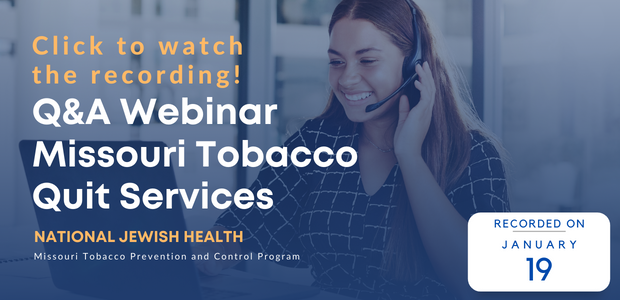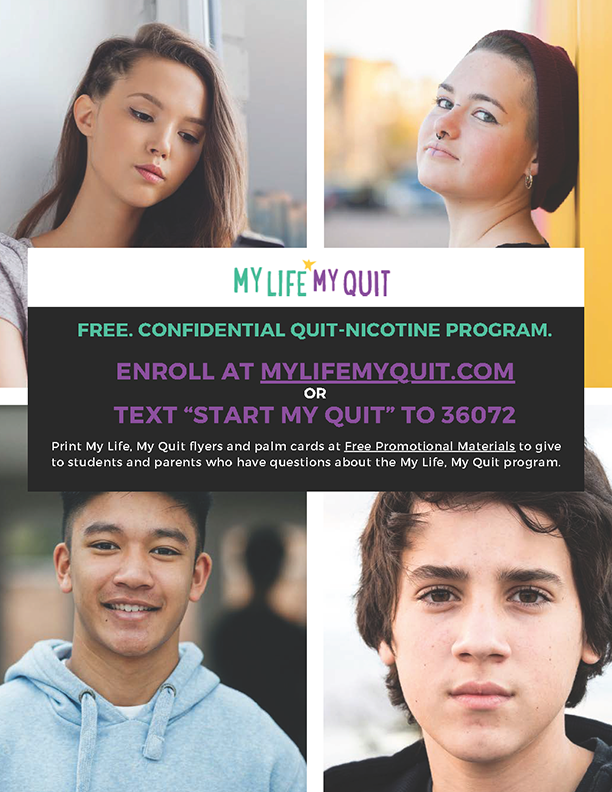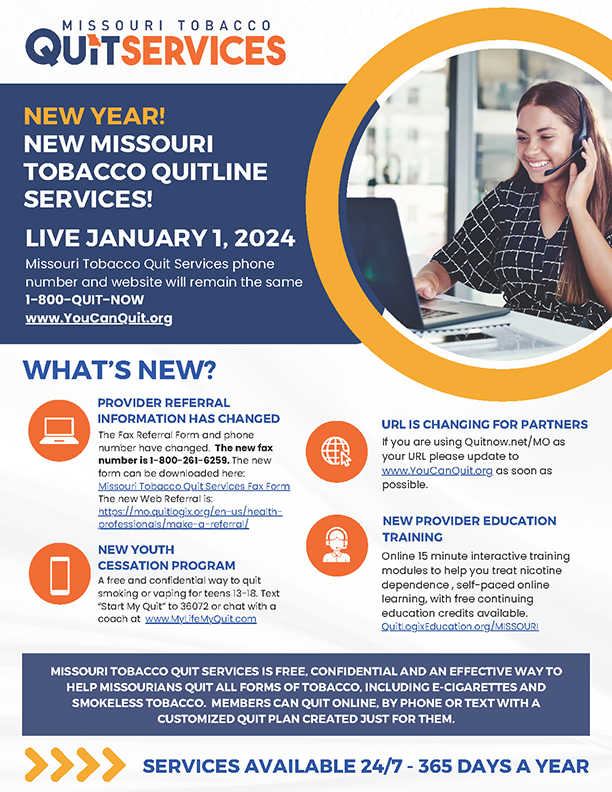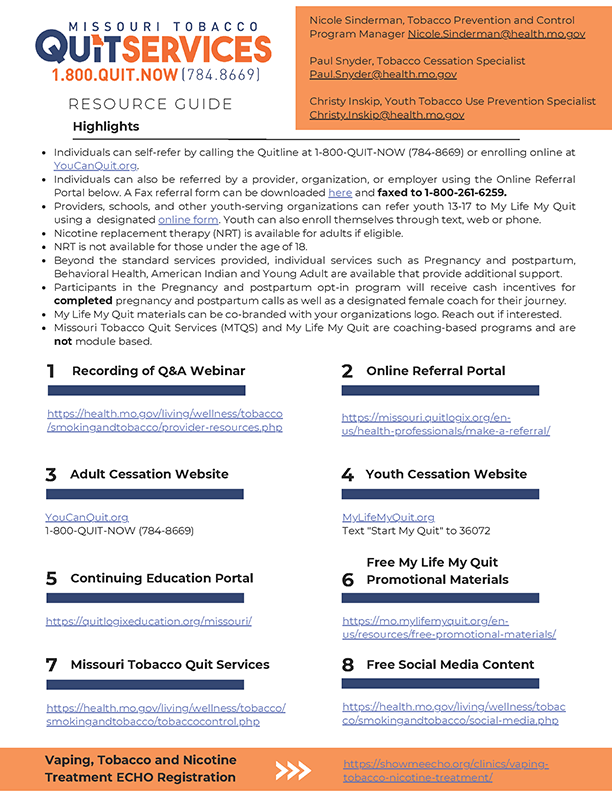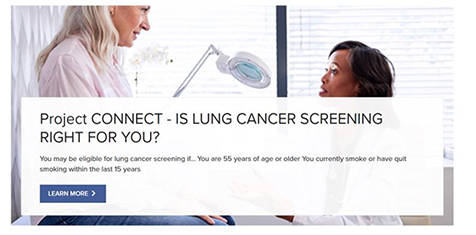Resources for HealthCare Providers

The number one cause of preventable death and disease in the United States is tobacco use. No matter what your specialty is, you know the drastic effects that tobacco use can have on patients.
If a physician advises a patient to quit just one time, it helps to double their chance for success. Patients trust their health care provider and they need guidance.
Talk and listen to the patient about tobacco use. Asking about 1-800-QUIT-NOW can be a conversation starter.
Missouri Tobacco Quit Services coaches are highly trained in cognitive behavioral therapy and experienced in helping patients live tobacco-free. Professional coaches have 240 hours of training, prior experience in counseling, and many more former smokers.
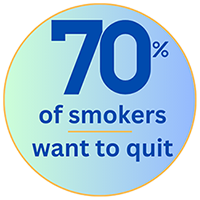
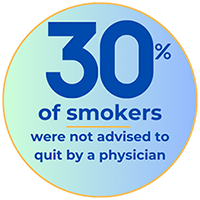
Click below to view the Q&A Webinar Recording
Download new service information flyers!
3 MINUTES OR LESS CAN SAVE LIVES
Every Patient / Every Visit / Non-Judgmental

- Ask if your patient uses tobacco.
- Ask what kind of tobacco is used and how often.
- Ask when was the last time the patient smoked or used any type of tobacco.
Be Clear / Be Strong / Be Personal
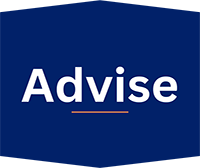
- Advise every tobacco user to quit. Quitting is the best decision.
- Advise those who weren’t successful with their previous quit attempts to try again.
- Employ a teachable moment: link health findings with advice. Quitting will help the patient and the health of their family.
Fax Referral / Online Referral / E- Referral

- Refer patients to Missouri Tobacco Quit Services 1-800-QUIT-NOW (784-8669).
- Fax Referral Form.
- Web-based Online Referral Portal.
- E-referral if your health system is set-up.
THE REFERRAL PROCESS
Complete all sections of the referrals, including patient information, and sign for consent as required by HIPAA. Fax forms to 1-800-261-6259. Missouri Tobacco Quit Services will fax a follow-up report back to your office.
The referral process is simple and effective. Missouri Tobacco Quit Services staff will reach out to your referred patient within 24 hours. They will make several attempts to reach the referred individual during their best time frame.
 Referral is sent and received.
Referral is sent and received.  Outbound calls are made within 24 hours.
Outbound calls are made within 24 hours.  If no contact is made, 5 additional attempts are made.
If no contact is made, 5 additional attempts are made.  The individual successfully enrolls.
The individual successfully enrolls. Progress reports are sent throughout, and a final report is sent to provider when the program is completed.
Progress reports are sent throughout, and a final report is sent to provider when the program is completed. Who should be screened for lung cancer?
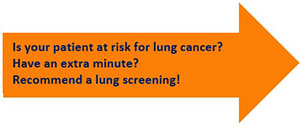
According to the Centers for Disease Control and Prevention (CDC) screening may be right for your patient if:
- They are between 50-80 years of age
- They currently smoke or have quit less than 15 years
- They smoke or have smoked, an average of one pack per day for at least 20 years
Quitting can help patients lower their risk for Lung Cancer. Being screened for lung cancer is important. Screening cannot prevent lung cancer, but screening may help find cancer while it is easier to treat. Lung cancer screening is not a substitute for quitting smoking. Refer patients to Project Connect to learn more about lung cancer screening and where they can be screened.
Free Nicotine Addiction Continuing Education
Get access to tools, resources, and educational modules to help you care for your patients with tobacco dependence. Free continuing education credits are available for the following trainings:
- Best Practices for Tobacco Cessation Using Medication and Behavioral Support
- Special Quitline Programs for Tobacco Cessation
- Tobacco Cessation for Behavioral Health Populations
- Connecting the Harms of Tobacco Use to Chronic Health Conditions
- Vaping and E-Cigarette Devices; What are they and how do they harm?
- Conversations for Screening, Responding, and Preventing Vaping
Sign up for free and complete the 15-minute interactive training modules at your own pace. Visit: https://quitlogixeducation.org/missouri/
 Tobacco Cessation Health Systems Change Webinar Series
Tobacco Cessation Health Systems Change Webinar Series
These one-hour webinars are presented by the University of Colorado Behavioral Health and Wellness program. Click on the links below to view recorded training.
- Evidence-Based Nicotine Treatment Strategies
- Implementing and sustaining Nicotine-Free Policies Electronic Nicotine Delivery Systems (ENDS) – What You Need To Know
- Strategies for Engaging Individuals in Tobacco Use Disorder Treatment
- Trauma-Informed Tobacco Use Disorder (TUD) Treatment
- Building Regional Partnerships

